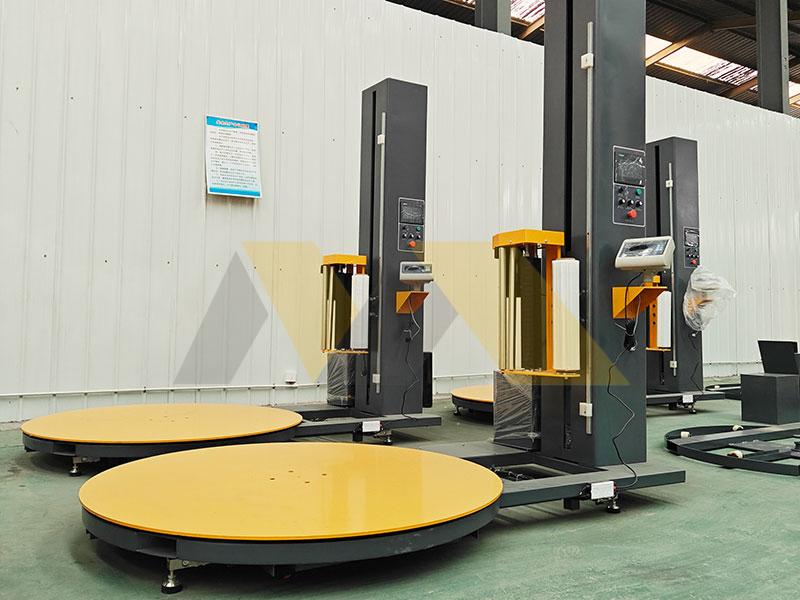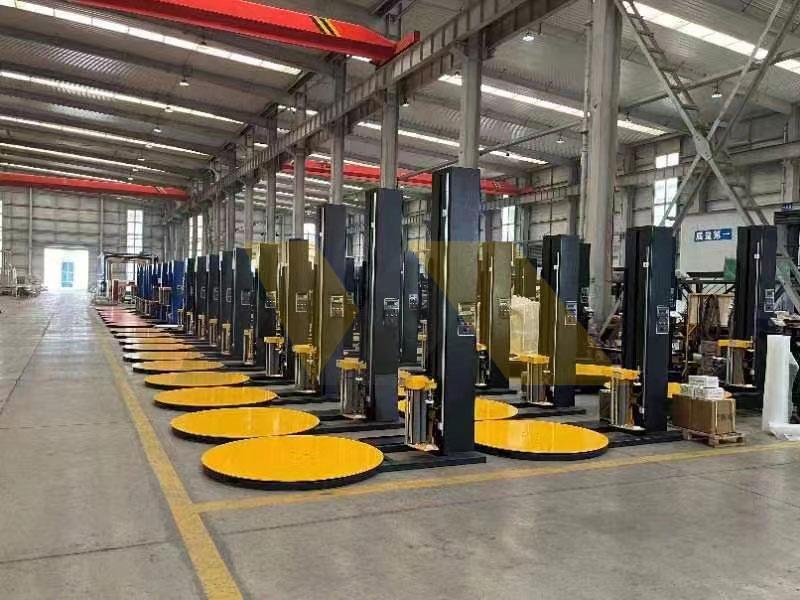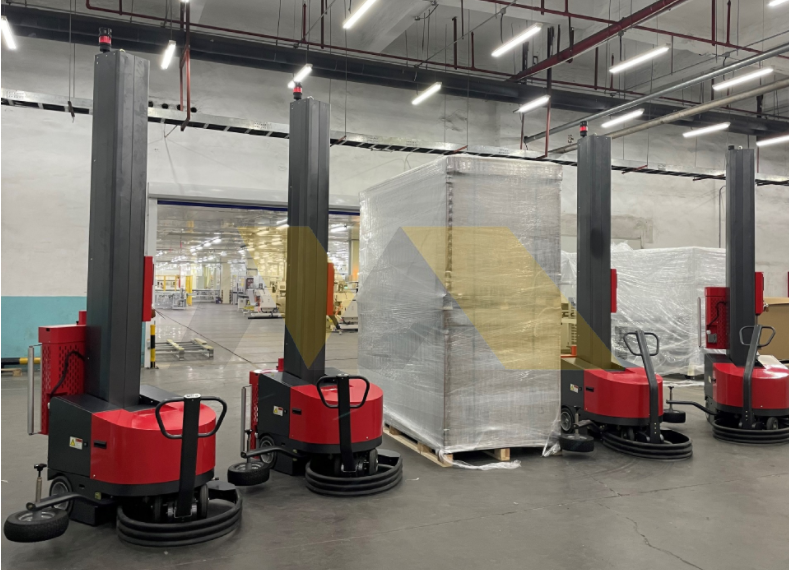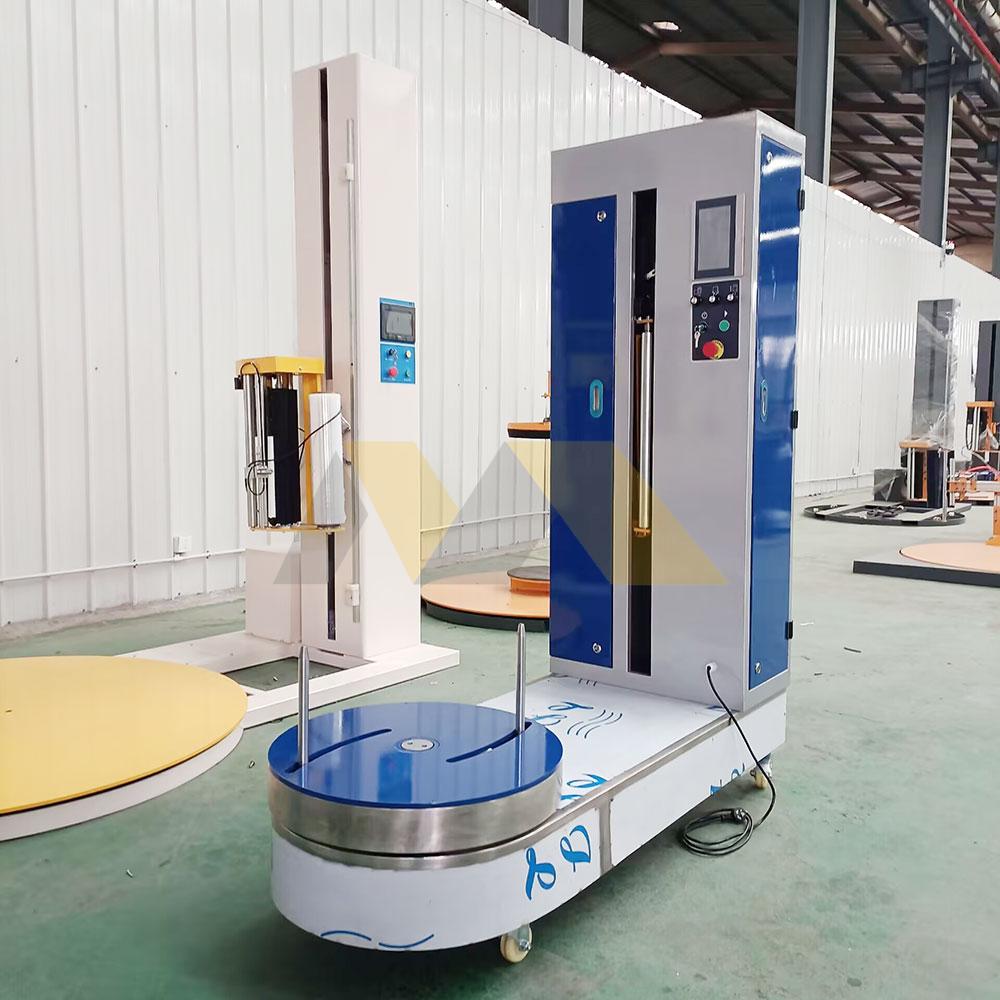
Running an airport luggage wrapping service means facing long lines and impatient travelers, right? Slow machines create bottlenecks, frustrate customers, and ultimately cost you revenue. You need equipment that keeps up with the rush.
Yes, for a busy airport business, a high-speed luggage wrapping machine is essential. These are specialized stretch wrappers engineered for rapid cycle times (often under 60 seconds), maximum durability for continuous use, user-friendly controls for quick operator training, and robust safety features suitable for public environments. They prioritize throughput without compromising wrap quality or reliability, directly impacting your service efficiency and customer satisfaction.
Investing in the right high-speed machine is critical. Feel free to reach out to discuss specific models designed for demanding airport environments and how they can boost your operation’s efficiency.
What machine does the airport use to wrap luggage?
You see them spinning bags at check-in, but what exactly are those machines? Understanding the specific type helps you choose the right equipment for speed and reliability.
Airports primarily use specialized semi-automatic stretch wrapping machines. These units typically feature a turntable where luggage is placed or, less commonly, a rotating arm that moves around stationary baggage. They are designed for durability, safety in public areas, and importantly for high-traffic zones, optimized cycle speed. They apply layers of stretch film tightly using controlled tension and pre-stretch mechanisms for efficiency and security.
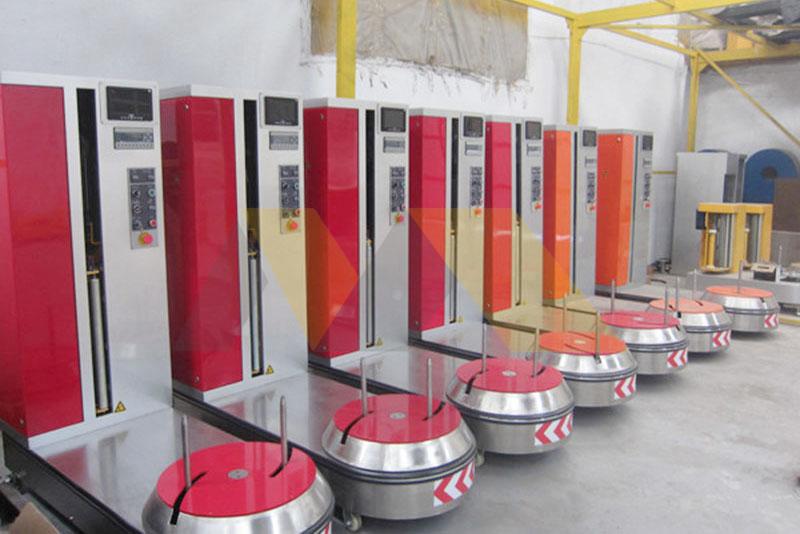
Knowing the type is the first step. If high throughput is your goal, focusing on models specifically engineered for airport speeds is key. Let’s explore the features that enable that speed.
Dive Deeper: Engineering for Airport Speed and Reliability
While the basic concept is stretch wrapping, airport machines aren’t just standard industrial wrappers plopped into a terminal. As a manufacturer, I know the specific engineering considerations that go into building a machine capable of handling the relentless pace of an airport. Speed is paramount, but it can’t come at the expense of reliability or safety.
Core Technology Optimized for Speed
- Stretch Film (LLDPE): We still use Linear Low-Density Polyethylene, but the combination of film quality and machine settings is critical for high-speed wrapping. Good film allows for higher tension and pre-stretch without breaking during fast rotation.
- Powered Pre-Stretch: This is non-negotiable for high-speed, efficient airport operations. Unlike simple friction brakes, powered pre-stretch systems use motors to stretch the film before it’s applied (often 250-300%). This not only saves significant amounts on film consumption (crucial for a high-volume business) but also allows for faster application with consistent tension, contributing to overall cycle speed. Our high-speed models feature robust, adjustable powered pre-stretch units designed for continuous operation.
- Turntable vs. Rotary Arm:
- Turntable: Most common for airport kiosks. The luggage spins on the platform. For high speed, these need powerful, reliable turntable drive motors and robust bearings (often slew bearings) capable of handling fast acceleration/deceleration and continuous use without overheating or excessive wear. The turntable size needs to accommodate common luggage dimensions quickly.
- Rotary Arm: The arm spins around stationary luggage. Can sometimes be faster for very large or unstable items, but the mechanics are more complex and usually take up more space. Less common for typical airport paid wrapping services but might be seen in integrated baggage systems. Our focus for airport kiosks is generally on optimizing turntable models for speed and footprint.
Key Components for High-Speed Performance
Achieving a sub-60-second wrap cycle reliably requires more than just turning up the speed dial.
- High-Performance Motors & Drives: We use motors with higher torque and responsiveness for the turntable rotation and film carriage ascent/descent. These are often paired with Variable Frequency Drives (VFDs) that allow fine-tuning of acceleration/deceleration ramps – starting and stopping smoothly but quickly is key to speed without destabilizing the luggage. Using established industrial brands known for reliability under load (Siemens, SEW, or top-tier Chinese brands) is essential. I remember a client whose previous machine used undersized motors – they were fast initially but burned out quickly under peak season load. We replaced it with one of our models specced for continuous high-throughput.
- Efficient PLC Programming: The Programmable Logic Controller (PLC) – the machine’s brain – needs optimized code. This ensures minimal delay between steps: starting rotation, engaging film carriage movement, sensing height, completing top/bottom wraps, stopping rotation, cutting/clamping film. Milliseconds saved in the programming logic add up over thousands of cycles. We use reliable PLC brands (like Siemens, Delta, Omron) and spend time refining the control logic for maximum speed and smoothness.
- Fast Film Cutting and Clamping: Automatic or semi-automatic film cut-and-clamp systems are vital. Waiting for an operator to manually cut and tuck the film adds precious seconds to each cycle. Reliable, fast-acting mechanisms here are crucial. We’ve refined our cut/clamp units for speed and reliability, minimizing jams or miscuts.
- Optimized Wrap Parameters: The PLC allows storing preset programs. Operators can quickly select a program for "Standard Suitcase," "Large Suitcase," etc., which automatically sets the optimal rotation speed, carriage speed, and number of top/bottom wraps for speed and effectiveness.
Durability and User Experience for Airport Environments
Speed is useless if the machine is constantly breaking down or hard to use.
- Robust Construction: Airport machines run for hours on end, often 16-24 hours a day during peak seasons. This demands heavier gauge steel frames, oversized bearings, durable rollers, and high-quality wiring protected against wear and tear. Our airport-specific models have reinforced structures compared to some standard industrial wrappers.
- Simplified Controls: Operators need to be trained quickly. Intuitive touch screens or simple button interfaces with clear status indicators reduce errors and speed up operation. Emergency stops must be prominent and easily accessible.
- Easy Film Loading: Minimizing downtime for film roll changes is important. Quick-change film carriage designs help operators swap rolls faster.
- Safety Features: Light curtains, safety bumpers on rotating parts, guarded mechanisms are essential in a public space. These must function reliably without causing unnecessary nuisance stops that slow down operation.
Building a true high-speed airport luggage wrapper is about system integration – matching powerful components with optimized programming and robust construction, all focused on delivering fast, reliable cycles, wrap after wrap. It’s an investment, but one that directly impacts throughput and revenue potential for an airport business.
How much does it cost to wrap your luggage at the airport?
Thinking about the price passengers pay, but what does that translate to for your business costs and revenue? Understanding the typical charges helps benchmark your service.
The cost for a traveler to wrap one piece of luggage at an airport service counter typically ranges from $10 to $25 USD or the local currency equivalent. Pricing varies based on the airport’s location (major hubs often cost more), the size of the bag, and the specific company providing the wrapping service. Optional extras like thicker film or straps can increase the price.
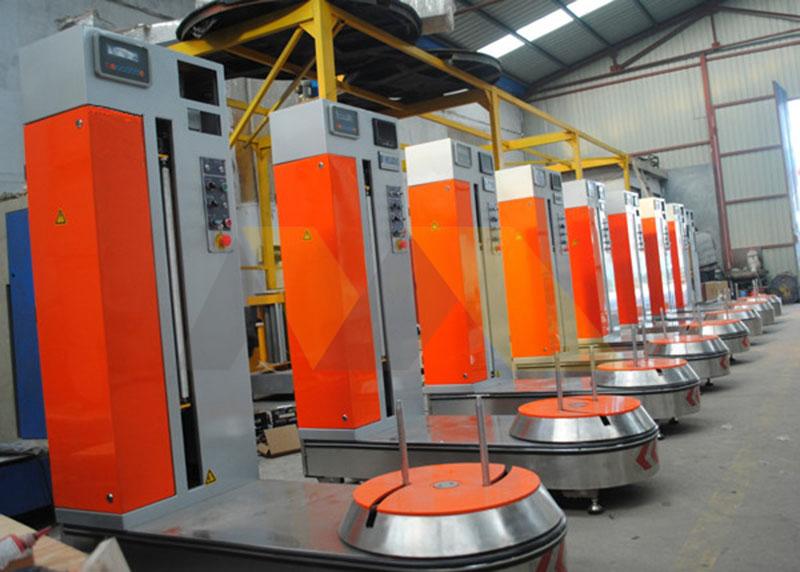
This price range is what customers see, but for your business, the key is maximizing throughput with a high-speed machine to make that price point profitable. Let’s talk about how reliable, fast equipment impacts your bottom line.
Dive Deeper: Cost Factors and the Role of Machine Speed
That $10-$25 price tag paid by the passenger isn’t pure profit for the airport service provider. It’s influenced by numerous operational costs, and the efficiency of your wrapping machine plays a surprisingly significant role in the financial viability of offering this service, especially when aiming for high volume.
Breakdown of Service Costs
Let’s revisit the factors contributing to the per-bag cost charged to passengers, but from the operator’s perspective:
- Airport Concession Fees/Rent: This is often the largest single operating expense. Prime locations in busy terminals command high fees, which must be recouped through service charges.
- Labor Costs: Staff wages to operate the machine, handle payments, and assist customers. In high-traffic locations, multiple staff might be needed during peak hours. Faster machines mean one operator can potentially handle more bags per hour, optimizing labor efficiency.
- Material Costs (Stretch Film): The cost of the LLDPE film itself. A high-speed machine with an efficient powered pre-stretch system (e.g., 250%) can use significantly less film per bag compared to a basic machine with low or no pre-stretch. If a standard machine uses ‘X’ amount of film, a high-pre-stretch machine might use X/3 or less. Over thousands of bags, this translates to substantial savings on consumables. My team always emphasizes calculating the film savings when discussing machine ROI with clients.
- Machine Purchase Cost (Amortization): The upfront cost of buying the high-speed wrapping machine. A high-quality, durable, high-speed machine will cost more initially than a basic model. This cost needs to be amortized over the machine’s expected operational lifespan.
- Maintenance and Repairs: Routine maintenance (cleaning, lubrication) and potential repairs for wear-and-tear parts (rollers, belts, cutting blades). A well-built, reliable high-speed machine should minimize unexpected downtime and repair costs, contributing to a lower Total Cost of Ownership (TCO), even if the purchase price was higher. Frequent breakdowns on a cheap machine quickly eat into profits.
- Utilities: Electricity to power the machine.
- Administrative Overhead: Business licenses, insurance, payment processing fees, etc.
- Profit Margin: The amount remaining after all costs are covered.
How Machine Speed Impacts Profitability
This is where investing in a high-speed machine directly influences the business case:
- Increased Throughput: This is the most obvious benefit. If a standard machine can wrap, say, 30 bags per hour, but a high-speed machine can reliably wrap 60+ bags per hour, you can serve twice as many customers in the same timeframe with the same amount of staff and fixed overhead (rent). During peak travel times, this ability to process passengers quickly without long queues is critical for maximizing revenue potential.
- Improved Labor Efficiency: Faster cycle times mean less idle time for the operator per transaction. They can serve more customers, making your staffing costs more productive.
- Enhanced Customer Satisfaction: Shorter queues lead to happier customers, potentially encouraging repeat business or positive word-of-mouth. Long waits can deter customers, even if they initially intended to use the service. I visited a client’s airport kiosk before and after they upgraded to our high-speed model. The difference in queue length and perceived customer stress during peak times was remarkable.
- Optimized Film Usage: As mentioned, the efficient pre-stretch systems typically found on better high-speed machines significantly reduce film consumption per bag, directly lowering material costs.
Calculating the ROI
When considering a high-speed machine, potential buyers like airport service managers need to look beyond the initial price tag. They should calculate the potential Return on Investment (ROI) based on:
- Estimated number of wraps per day/month.
- Revenue per wrap ($10-$25).
- Film savings per wrap due to high pre-stretch.
- Potential increase in wraps per hour due to speed.
- Estimated operational life and reliability (lower maintenance/downtime costs).
A higher initial investment in a robust, genuinely high-speed machine can often yield a much faster ROI and higher overall profitability compared to struggling with a slower, less reliable, or less efficient basic model in a demanding airport environment. We often help prospective clients run these kinds of comparisons.
What is the airport luggage machine called?
Using the right name helps when searching for suppliers or discussing equipment. Is there a single correct term for the machine that wraps luggage at airports?
While often casually called a "luggage wrapper" or "baggage wrapping machine," the technically accurate term for the core equipment is a "stretch wrapping machine" or "stretch wrapper," specifically adapted for luggage. You’ll also hear terms like "airport luggage wrapping station" or "wrapping kiosk" referring to the entire service point, including the machine.
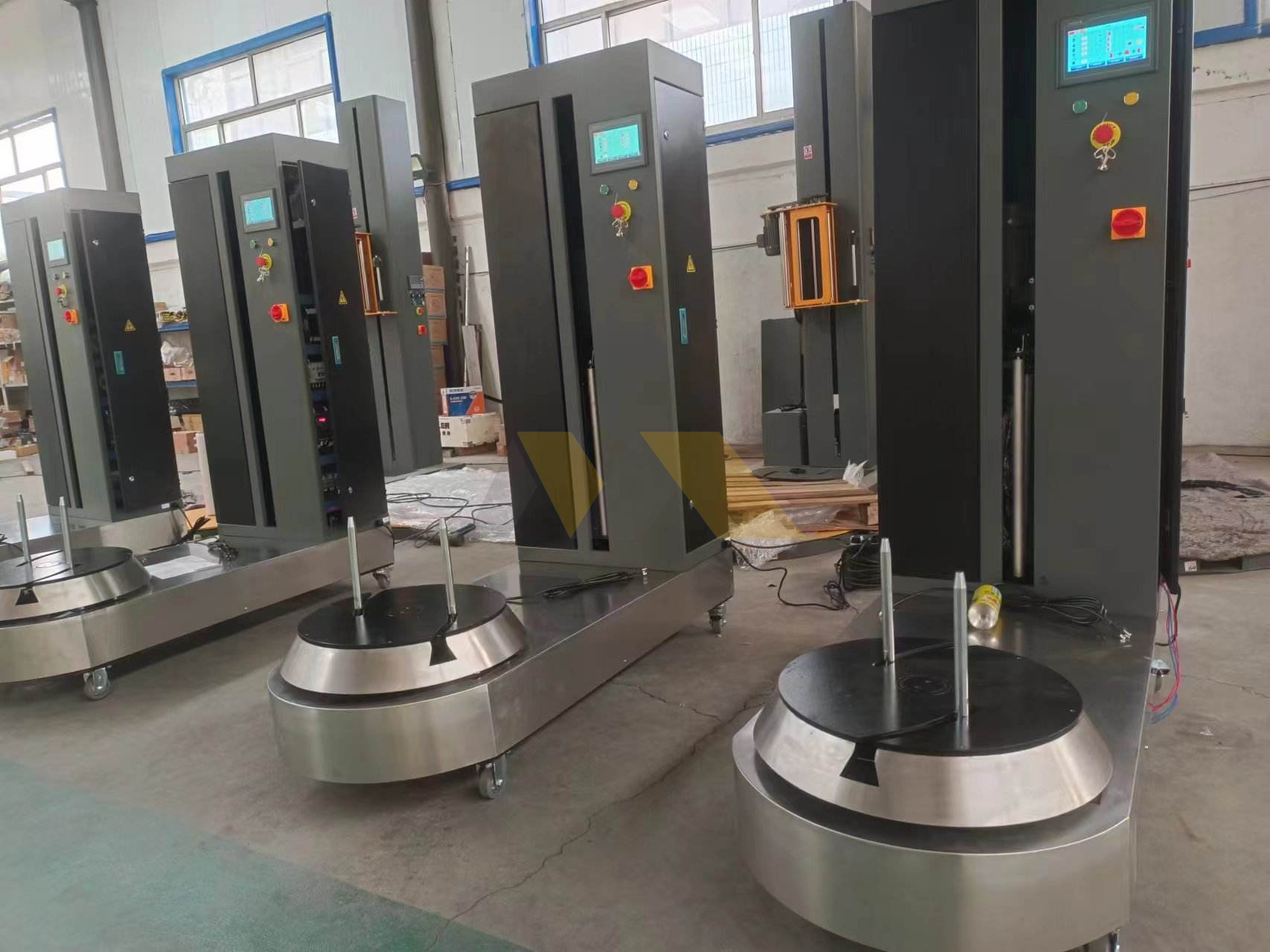
Knowing these terms helps clarify your needs. When sourcing, specifying "high-speed semi-automatic stretch wrapper for luggage" ensures suppliers understand you need airport-grade equipment. Let’s discuss why precision matters here.
Dive Deeper: Terminology Matters When Sourcing High-Speed Machines
Using the correct terminology isn’t just about being technically precise; it’s crucial for effective communication when sourcing specialized equipment like a high-speed luggage wrapper, especially from international suppliers like my factory. Misunderstandings can lead to quoting the wrong machine or missing key features.
Common Names vs. Technical Terms
- Public/Casual Terms:
- "Luggage Wrapper" / "Baggage Wrapper": Very common and easily understood in context.
- "Plastic Wrap Machine": Describes what passengers see.
- "Airport Wrapping Thingy": Less helpful, but you get the idea!
- "Wrapping Station" / "Wrapping Kiosk": Refers to the whole setup – the machine, counter, payment system, operator space.
- Industry/Technical Terms:
- Stretch Wrapping Machine / Stretch Wrapper: This is the core technical name for the machine type. It uses stretch film applied under tension.
- Turntable Stretch Wrapper: Specifies the common configuration where the load rotates.
- Rotary Arm Stretch Wrapper: Specifies the configuration where the arm rotates around a stationary load.
- Semi-Automatic Stretch Wrapper: Indicates operator involvement is needed to start the cycle, place/remove the load, and typically cut the film (though high-speed versions often automate the cut/clamp).
- Luggage Stretch Wrapper: Adds the specific application.
Why Precision is Key for High-Speed Needs
When you’re specifically looking for a high-speed machine suitable for a demanding airport environment, using more precise technical terms helps ensure suppliers understand your requirements:
- Filtering Suppliers: Searching for "high-speed semi-automatic luggage stretch wrapper" is more likely to connect you with manufacturers (like us) who specialize in or have models specifically designed for this application, rather than suppliers who only offer basic industrial pallet wrappers.
- Clear Specifications: Using terms like "powered pre-stretch system (250%)", "target cycle time <60 seconds", "turntable diameter XXXmm", "max wrapping height YYYmm", "PLC controlled (specify brand preference if any)" leaves less room for ambiguity in quotes and contracts. I recall a potential client asking only for a "cheap baggage wrapper." We had to spend significant time clarifying their actual needs – throughput, load size, features – before we could even quote. Starting with precise terms saves time.
- Comparing Apples to Apples: When you receive quotes from different suppliers, having used specific terminology ensures you are comparing machines with similar capabilities. A quote for a basic "luggage wrapper" might be much cheaper but lack the speed, durability, and efficiency features of a true "high-speed airport model."
- Avoiding Confusion with Other Airport Equipment: Airports are full of complex machinery. Being specific ensures you’re not accidentally inquiring about baggage conveyor belts, check-in systems, or security screening equipment (X-ray machines, etc.).
Key Terms to Use When Discussing with Suppliers:
- Machine Type: Semi-Automatic Turntable Stretch Wrapper for Luggage
- Performance: Target Cycle Time (e.g., under 60 seconds), Required Throughput (bags/hour)
- Capacity: Max Load Dimensions (L x W x H), Max Load Weight (kg/lbs)
- Key Features: Powered Pre-Stretch System (specify desired % range), Control System (PLC Brand preference?), Automatic Film Cut/Clamp
- Electrical: Voltage, Frequency (Hz), Phase
- Environment: Airport Terminal Use (implies need for durability, safety features)
As a manufacturer, when a potential buyer uses specific terminology, it signals they have a clearer understanding of their needs, allowing for a more efficient and accurate quoting process. It helps us recommend the right model from our range that truly meets their high-speed requirements.
How much does it cost to cling wrap at the airport?
You might hear people call it "cling wrap." Does this mean it’s a different service or cost compared to the usual luggage wrapping? Let’s clarify.
"Cling wrap" at the airport almost always refers to the same service as standard luggage stretch wrapping. The cost remains in the typical range of $10 to $25 USD per bag, influenced by airport location, luggage size, and the service provider. The terminology difference ("cling wrap" vs. "stretch wrap") doesn’t usually affect the price paid by the passenger for the standard wrapping service.
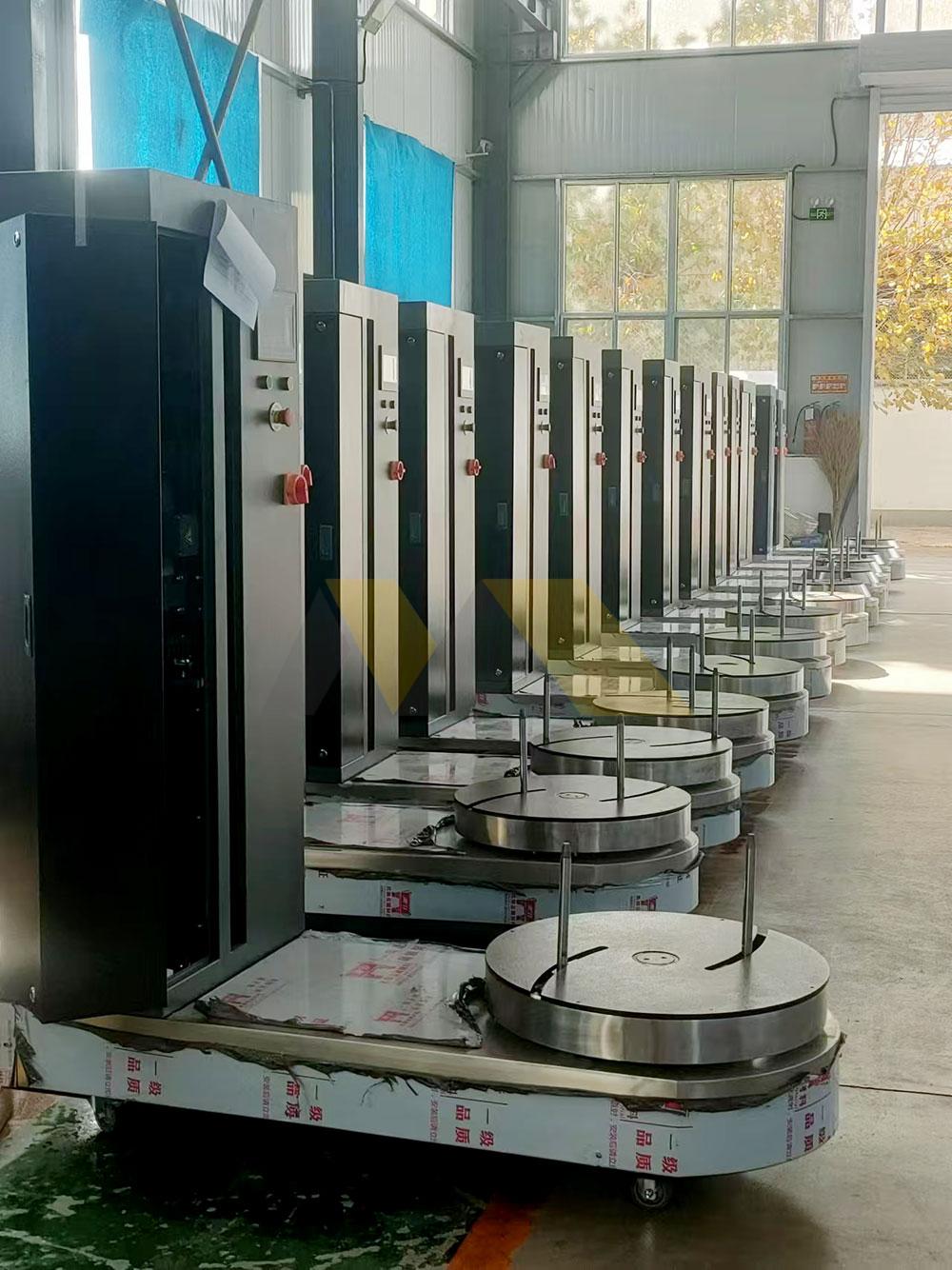
So, the cost is generally the same regardless of the name used. For your business, focusing on the efficiency and reliability of your stretch wrapping machine remains the key factor for profitability. Let’s discuss how quality equipment ensures value for that $10-$25 charge.
Dive Deeper: Clarifying "Cling Wrap" and Reinforcing Value
While passengers might use the term "cling wrap," it’s helpful for you as a service provider or potential machine buyer to understand the nuance and how it relates back to the service cost and the machine’s role.
"Cling Wrap" vs. "Stretch Wrap" – Technical Distinction
- Stretch Wrap (LLDPE): The film used for luggage wrapping is technically Linear Low-Density Polyethylene (LLDPE). Its key properties are high stretchability (it’s elongated significantly under tension) and cling (it sticks to itself without adhesive). This combination provides the tight, secure wrap needed for baggage handling. Our machines are designed specifically to work with the properties of LLDPE stretch film, particularly utilizing powered pre-stretch.
- Cling Film/Wrap (Often PVC or non-LLDPE): The term "cling film" or "cling wrap" is most commonly associated with thinner plastic films used in kitchens for covering food, often made from PVC or other polyethylene types. While these films also cling, they typically have much lower stretch ratios and puncture resistance compared to industrial LLDPE stretch wrap.
Why the Confusion? Because LLDPE stretch wrap does cling to itself, passengers observing the process naturally use the familiar term "cling wrap." For the purpose of the airport service, the terms are used interchangeably by the public, and the service offered is the application of LLDPE stretch wrap.
Does the Terminology Affect the $10-$25 Cost?
Generally, no. The price charged by the service provider is based on the operational costs and market rates for applying protective stretch film to luggage, regardless of whether the customer calls it cling wrap or stretch wrap. The core factors influencing the price remain:
- Airport Fees & Rent: Still the primary cost driver.
- Labor: Operator wages.
- Material: Cost of the LLDPE stretch film roll.
- Machine: Amortization, maintenance, electricity.
- Overhead & Profit: Business running costs and desired margin.
There could be a theoretical price difference if a provider offered a premium wrap using significantly thicker LLDPE film or perhaps a different type of specialty film, but the standard service cost advertised usually covers the application of standard LLDPE stretch wrap.
Connecting Cost Back to High-Speed Machine Value
Understanding that "cling wrap" means the standard stretch wrap service reinforces why the quality and speed of your machine are paramount to justifying that $10-$25 charge and running a profitable business:
- Delivering Value for Money: Passengers pay for protection and security. A high-speed machine with excellent tension control and pre-stretch ensures a tight, secure wrap every time. A cheap machine might produce loose wraps that offer little real protection, undermining the value proposition.
- Efficiency Justifies Costs: Your ability to cover high operating costs (like rent and labor) depends on processing sufficient volume. A high-speed machine enables this volume. If your machine is slow or unreliable, you might struggle to wrap enough bags to cover costs and make a profit at the standard price point.
- Consistency: A reliable high-speed machine delivers a consistent quality wrap, bag after bag. This consistency builds customer confidence and justifies the standard charge. Variable wrap quality due to machine issues erodes trust.
As a manufacturer, even though the public might use casual terms like "cling wrap," we focus on engineering robust stretch wrapping machines optimized for airport speeds. We know that the reliability and efficiency of our equipment are fundamental to our clients being able to offer a valuable service consistently and profitably, regardless of what their customers call the plastic film. It’s about ensuring the machine reliably delivers the protection and peace of mind that passengers are paying for.
Conclusion
For airport luggage wrapping businesses, speed is revenue. Investing in a specialized, high-speed stretch wrapping machine is crucial for managing queues, maximizing throughput, and ensuring profitability. These durable machines, often called luggage wrappers or technically stretch wrappers, justify the typical $10-$25 wrapping cost by delivering consistent, secure protection efficiently. Choosing a reliable supplier for high-performance equipment is key to success.

